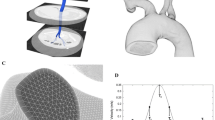Summary
The present study was carried out to determine the hydrodynamic structure of flow in an aortic arch and to correlate the findings with the possible involvement of fluid dynamics in atherogenesis and thrombogenesis. Each aorta was made transparent under a transmural pressure of 100 mmHg to maintain its in vivo configuration. Methyl salicylate with a kinematic viscosity of 2.6 cSt was substituted for blood and polystyrene microspheres, 0.08–0.30 mm in diameter, were used to trace the streamlines of the flow. Flow disturbances observed in the aortic arch have characteristics similar to those of secondary flow, which is called the horseshoe vortex, produced at Y- and T-junctions. The particles captured by the secondary flow near the flow divider, for instance, moved in a direction opposite or perpendicular to the mean flow. The vortex produced a typical stagnation region at the wall of the aorta just proximal to the branching site of the brachiocephalic and the left subclavian arteries. When the rate of flow to a daughter branch decreased, separation of the flow occurred at the proximal outer wall of the branch artery. Comparison between the present results and the topographical patterns of atherosclerosis reported in the literature suggests that it is in such low-shear regions that lipid deposition tends to occur most frequently.
Similar content being viewed by others
References
Wolf S, Werthessen NT; eds (1979) Dynamics of arterial flow. Plenum Press, New York
Nerem RM (1981) Arterial fluid dynamics and interactions with the vessel walls. In: Schwartz CJ, Werthessen NT, Wolf S (eds) Structure and function of the circulation. Plenum Press, New York, pp 719–835
Goldsmith HL, Karino T (1979) Mechanically induced thromboemboli. In: Hwang NHC, Norman NA (eds) Quantitative cardiovascular studies — Clinical and research applications of engineering principles. University Park Press, Baltimore, pp 289–351
Roach MR (1972) Poststenotic dilatation in arteries. In: Bergel DH (ed) Cardiovascular fluid dynamics. Academic Press, London, pp 111–139
Roach MR, Scott S, Ferguson GG (1972) The hemodynamic importance of the geometry of bifurcations in the circle of Willis (glass model studies). Stroke 3: 255–267
Stehbens WE (1975) Flow in glass models of arterial bifurcations and berry aneurysms at low Reynolds numbers. Q J Exp Pathol 60: 181–192
Brech R, Bellhouse BJ (1973) Flow in branching vessels. Cardiovasc Res 7: 593–600
Rodkiewicz CM (1975) Localization of early atherosclerotic lesions in the aortic arch in the light of fluid flow. J Biomech 8: 149–156
Pinchak AC, Ostrach S (1976) Blood flow in branching vessels. J Appl Physiol 41: 646–658
Lutz RJ, Cannon JN, Bishoff KB, Deadrick RL, Stiles RK, Fry DL (1975) Wall shear stress distribution in a model canine artery during steady flow. Circ Res 36: 277–285
ElMasry OA, Feuerstein IA, Round GF: Experimental evaluation of streamline patterns and separated flows in a series of branching vessels with implications for atherosclerosis and thrombosis. Circ Res 43: 608–618
Farthing SP, Peronneau P (1979) Flow in the thoracic aorta. Cardiovasc Res 13: 607–620
Walburn FJ, Stein PD (1981) Velocity profiles in symmetrically branched tubes simulating the aortic bifurcation. J Biomech 14: 601–611
Lutz RJ, Hsu L, Menawat A, Zrubek J, Edwards K (1983) Comparison of steady and pulsatile flow in a double branching arterial model. J Biomech 16: 753–766
Karino T, Motomiya M (1983) Flow visualization in isolated transparent natural blood vessels. Biorheology 20: 119–127
Fukushima T, Azuma T (1982) The horseshoe vortex: A secondary flow generated in arteries with stenosis, bifurcation, and branchings. Biorheology 19: 143–154
Azuma T, Fukushima T (1976) Flow patterns in stenotic blood vessel models. Biorheology 13: 337–355
Levine R, Goldsmith HL (1977) Particle behavior in flow through small bifurcations. Microvasc Res 14: 319–344
Fukushima T, Azuma T (1982) Patterns of pulsatile flow in arterial models with stenosis. Clin Hemorheol 2: 31–41
Caro CG, Fitz-Gerald JM, Schroter RC (1971) Atheroma and arterial wall shear: Observation, correlation and proposal for a shear dependent mass transfer mechanism for atherogenesis. Proc R Soc Lond [Biol] 117: 109–159
Sakata N, Joshita S, Ooneda G (1984) Topographical study on atherosclerotic lesions at the bifurcation of human cerebral arteries. Proceedings of the Annual Meeting of Japan Society of Biorheology (Sapporo), pp 151–154
Author information
Authors and Affiliations
Rights and permissions
About this article
Cite this article
Fukushima, T., Karino, T. & Goldsmith, H.L. Disturbances of flow through transparent dog aortic arch. Heart Vessels 1, 24–28 (1985). https://doi.org/10.1007/BF02066483
Issue Date:
DOI: https://doi.org/10.1007/BF02066483




